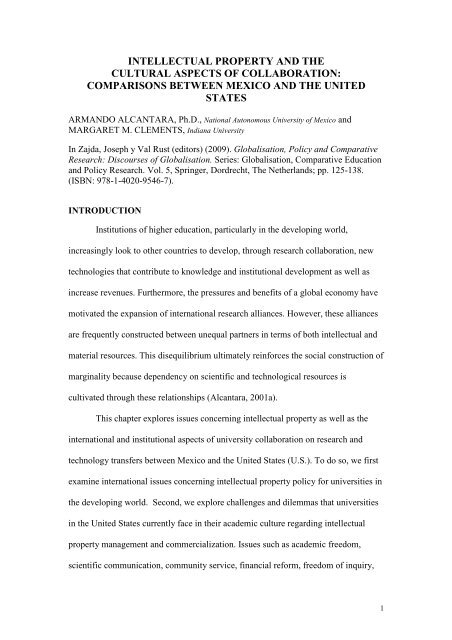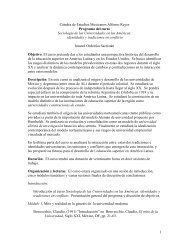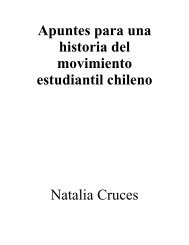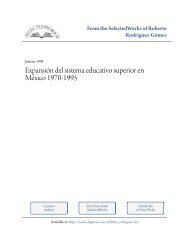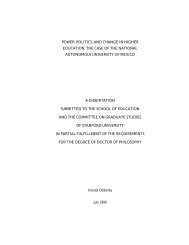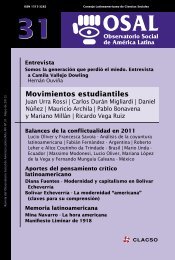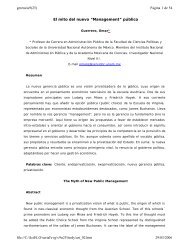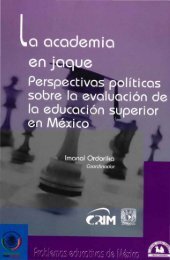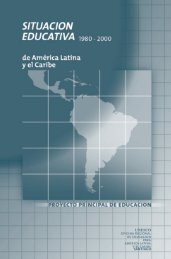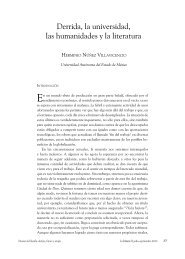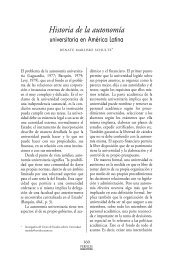intellectual property and the cultural aspects of collaboration
intellectual property and the cultural aspects of collaboration
intellectual property and the cultural aspects of collaboration
You also want an ePaper? Increase the reach of your titles
YUMPU automatically turns print PDFs into web optimized ePapers that Google loves.
INTELLECTUAL PROPERTY AND THECULTURAL ASPECTS OF COLLABORATION:COMPARISONS BETWEEN MEXICO AND THE UNITEDSTATESARMANDO ALCANTARA, Ph.D., National Autonomous University <strong>of</strong> Mexico <strong>and</strong>MARGARET M. CLEMENTS, Indiana UniversityIn Zajda, Joseph y Val Rust (editors) (2009). Globalisation, Policy <strong>and</strong> ComparativeResearch: Discourses <strong>of</strong> Globalisation. Series: Globalisation, Comparative Education<strong>and</strong> Policy Research. Vol. 5, Springer, Dordrecht, The Ne<strong>the</strong>rl<strong>and</strong>s; pp. 125-138.(ISBN: 978-1-4020-9546-7).INTRODUCTIONInstitutions <strong>of</strong> higher education, particularly in <strong>the</strong> developing world,increasingly look to o<strong>the</strong>r countries to develop, through research <strong>collaboration</strong>, newtechnologies that contribute to knowledge <strong>and</strong> institutional development as well asincrease revenues. Fur<strong>the</strong>rmore, <strong>the</strong> pressures <strong>and</strong> benefits <strong>of</strong> a global economy havemotivated <strong>the</strong> expansion <strong>of</strong> international research alliances. However, <strong>the</strong>se alliancesare frequently constructed between unequal partners in terms <strong>of</strong> both <strong>intellectual</strong> <strong>and</strong>material resources. This disequilibrium ultimately reinforces <strong>the</strong> social construction <strong>of</strong>marginality because dependency on scientific <strong>and</strong> technological resources iscultivated through <strong>the</strong>se relationships (Alcantara, 2001a).This chapter explores issues concerning <strong>intellectual</strong> <strong>property</strong> as well as <strong>the</strong>international <strong>and</strong> institutional <strong>aspects</strong> <strong>of</strong> university <strong>collaboration</strong> on research <strong>and</strong>technology transfers between Mexico <strong>and</strong> <strong>the</strong> United States (U.S.). To do so, we firstexamine international issues concerning <strong>intellectual</strong> <strong>property</strong> policy for universities in<strong>the</strong> developing world. Second, we explore challenges <strong>and</strong> dilemmas that universitiesin <strong>the</strong> United States currently face in <strong>the</strong>ir academic culture regarding <strong>intellectual</strong><strong>property</strong> management <strong>and</strong> commercialization. Issues such as academic freedom,scientific communication, community service, financial reform, freedom <strong>of</strong> inquiry,1
<strong>and</strong> policy are all implicated in this rapidly changing academic culture. Third, wedescribe a series <strong>of</strong> regulatory changes implemented at <strong>the</strong> National AutonomousUniversity <strong>of</strong> Mexico (UNAM) to protect <strong>intellectual</strong> <strong>property</strong> rights (industrial<strong>property</strong> <strong>and</strong> copyright). Finally, we broadly describe programs for technologytransfer between Mexico <strong>and</strong> U. S. institutions <strong>of</strong> higher education. Some <strong>of</strong> <strong>the</strong>implications <strong>of</strong> <strong>the</strong> collaborative initiatives are discussed as well.INTERNATIONAL ISSUES OF INTELLECTUAL PROPERTY POLICY INTHE DEVELOPING WORLDThe notion <strong>of</strong> <strong>intellectual</strong> <strong>property</strong> as private <strong>property</strong> varies around <strong>the</strong> globe.In <strong>the</strong> nineteenth century, very heated debates ensued in Europe over <strong>the</strong> patentsystem developed in Italy <strong>and</strong> in Engl<strong>and</strong> between <strong>the</strong> fifteenth <strong>and</strong> seventeenthcenturies (Machlup & Penrose, 1950). Despite efforts to unite procedures involvinginternational patent protection through international organizations such as <strong>the</strong> NorthAmerican Free Trade Agreement (NAFTA) <strong>and</strong> <strong>the</strong> European Union (EU), in practiceindividual countries remain divided over policies involving <strong>the</strong> protection <strong>of</strong><strong>intellectual</strong> <strong>property</strong>. Fur<strong>the</strong>rmore, especially for historically communist, socialist<strong>and</strong> developing nations, <strong>intellectual</strong> <strong>property</strong> has a strong element <strong>of</strong> communityinvestment in which <strong>the</strong> society perceives a right to share in <strong>the</strong> resulting pr<strong>of</strong>its (Isla,2000; Noetinger & Veirano, 2000; Masuda, 2000; Poltorak, 2000; Von, 2000). Since<strong>the</strong> fall <strong>of</strong> <strong>the</strong> former Soviet Union, however, most countries have been aligning <strong>the</strong>ir<strong>intellectual</strong> <strong>property</strong> laws <strong>and</strong> policies with those espoused by a market economy <strong>and</strong><strong>the</strong> industrialized world (Altbach, 1996; Nesvetailov, 1995; Qiping & White, 1994;Sell, 1995). Specifically, <strong>the</strong> United States has applied significant pressure on o<strong>the</strong>rcountries to streng<strong>the</strong>n <strong>and</strong> protect <strong>intellectual</strong> <strong>property</strong> rights through multinationalcorporations <strong>and</strong> international forums such as <strong>the</strong> United Nations Conference on2
Trade <strong>and</strong> Development (UNCTAD), <strong>the</strong> World Trade Organization (WTO), <strong>the</strong>Trade <strong>and</strong> Tariff Acts <strong>of</strong> 1984 <strong>and</strong> 1988, <strong>and</strong> <strong>the</strong> NAFTA (Gereffi, 1978; Machlup &Penrose, 1973; Sell, 1995). While political pressure has helped curb pirating <strong>and</strong><strong>intellectual</strong> <strong>property</strong> <strong>the</strong>ft <strong>and</strong> infringement, <strong>the</strong> research literature suggests thatthrough actual involvement <strong>and</strong> pr<strong>of</strong>it from research activities, o<strong>the</strong>r countries arebeginning to perceive <strong>and</strong> enforce <strong>the</strong> spirit <strong>of</strong> <strong>the</strong> laws protecting <strong>intellectual</strong><strong>property</strong> (Altbach, 1996; Gil, 1996; Haas, 1996; Sell, 1995; Task Force, 2000). As anhistorically vulnerable trading partner, Mexico has been especially susceptible topressures to realign <strong>intellectual</strong> <strong>property</strong> laws more closely to those <strong>of</strong> <strong>the</strong> Unitedstates (Gereffi, 1978; Sell, 1995)Recently, a team sponsored by <strong>the</strong> World Bank <strong>and</strong> <strong>the</strong> United NationsEducational, Scientific <strong>and</strong> Cultural Organization (UNESCO) argued for reforms in<strong>intellectual</strong> <strong>property</strong> rights protection for higher education. The special team contendsthat in an increasingly global world it is important to protect investments made in <strong>the</strong>production <strong>of</strong> knowledge. However, most patents protect a variety <strong>of</strong> advances <strong>and</strong>inventions made in industrial nations—not in developing nations. As an illustration,immigrant scientists represent a growing <strong>and</strong> significant share <strong>of</strong> <strong>the</strong> U.S. science <strong>and</strong>engineering workforce. The impact <strong>of</strong> <strong>the</strong>se immigrant scientists is expressed mostintensely at <strong>the</strong> highest levels <strong>of</strong> education. While foreign-born scientists representonly 9.7% <strong>of</strong> all U.S. scientists <strong>and</strong> engineers with a bachelor’s degree, <strong>the</strong>y represent19.2% <strong>of</strong> all U.S. scientists <strong>and</strong> engineers with masters’ degrees <strong>and</strong> 26.1% <strong>of</strong> all U.S.scientists <strong>and</strong> engineers with doctoral degrees (National Science Board, 2000). Someestimates have been made <strong>of</strong> <strong>the</strong> relative importance <strong>of</strong> international students on <strong>the</strong>U.S. economy in terms <strong>of</strong> <strong>the</strong>ir contribution to <strong>the</strong> services sector. The NationalAssociation <strong>of</strong> Foreign Student Advisors (NAFSA), for example, estimates that3
foreign students directly spent $12.3 billion in <strong>the</strong> U.S. economy during academicyear 1999/2000. This direct spending figure, however, grossly underestimates <strong>the</strong>overall impact <strong>of</strong> <strong>the</strong>se international students on <strong>the</strong> U.S. economy. Likewise, <strong>the</strong>re isno economic indicator that adequately captures <strong>the</strong> significance <strong>of</strong> <strong>the</strong> presence <strong>of</strong><strong>the</strong>se foreign thinkers to <strong>the</strong> U.S. economy or <strong>the</strong>ir absence from <strong>the</strong> economy <strong>of</strong> <strong>the</strong>irnation <strong>of</strong> origin. In general, only simplistic measures exist that preclude morepr<strong>of</strong>ound thinking <strong>and</strong> reporting on <strong>the</strong> overall impact <strong>of</strong> global science <strong>and</strong>engineering exchanges on international measures <strong>of</strong> gross domestic product (GDP).A commonly used comparison in international trade is represented bycontrasting receipts with payments <strong>of</strong> royalties <strong>and</strong> license fees generated fromindustrial processes. No such data exists that would show <strong>the</strong> economic impact <strong>of</strong> <strong>the</strong>higher education sector on international trade. A recent study by Lawrence Davidson(2003) includes higher education in what he defines as a “quiet export sector” thatonly begins to estimate <strong>the</strong> importance <strong>of</strong> higher education in <strong>the</strong> internationalmeasurement <strong>of</strong> services. To give a brief idea <strong>of</strong> <strong>the</strong> trade balance between <strong>the</strong>NAFTA nations, Table 1, below, shows <strong>the</strong> difference between Canada <strong>and</strong> Mexico inboth receipts <strong>and</strong> payments <strong>of</strong> royalties <strong>and</strong> license fees to <strong>the</strong> United States generatedfrom industrial processes:Table 1: U.S. receipts <strong>and</strong> payments <strong>of</strong> royalties <strong>and</strong> license fees generated from <strong>the</strong> exchange <strong>and</strong> use<strong>of</strong> industrial processes in millions <strong>of</strong> U.S. dollarsYear Canada Mexico Canada MexicoU.S. Receipts in Millions <strong>of</strong> $ U.S. Payments in Millions <strong>of</strong> $1987 87 14 9 31988 60 13 11 *1989 62 18 8 *1990 79 23 16 *1991 62 31 11 *1992 47 29 10 11993 41 28 8 *1994 54 33 11 14
1995 55 24 13 D1996 81 26 57 *1997 82 25 76 DSource: National Science Board, 2000This table illustrates that while U.S. receipts from Canada have actually declined over<strong>the</strong> last ten years, Mexican dependency on technology has evidently grown. Bycontrast, U.S. payments to Canada have increased while payments to Mexico areei<strong>the</strong>r negligible (*) or concealed due to corporate privacy (D) rights.Universities <strong>and</strong> research institutions are particularly relevant to <strong>the</strong> globalsystem <strong>of</strong> innovation due to 1) <strong>the</strong> direct training <strong>the</strong>y provide to scientists <strong>and</strong>engineers, 2) <strong>the</strong>ir significant contribution to basic science, <strong>and</strong> 3) <strong>the</strong>ir directproduction <strong>of</strong> new technologies <strong>and</strong> products. Just as Table 1, above illustratesMexico’s growing dependency on technologies produced in <strong>the</strong> U.S., countriesthroughout <strong>the</strong> developing world face significant <strong>and</strong> similar financial hurdles toresearch as those experienced by Mexico. At <strong>the</strong> higher education level, <strong>the</strong>seimpediments include limited capacity for investment in research <strong>and</strong> developmentactivities, low numbers <strong>of</strong> scientists <strong>and</strong> engineers trained at <strong>the</strong> highest levels, lowdem<strong>and</strong> by industry for <strong>the</strong> research expertise at universities in <strong>the</strong> developing worldas well as more pressing social dem<strong>and</strong>s like health care, energy, food, education <strong>and</strong>pollution control (Alcantara, 2001b). Given this example, it is foreseeable that entireregions may find <strong>the</strong>mselves excluded from participation in <strong>the</strong> global system <strong>of</strong>innovation (Task Force, 2000).The Task Force warns that although this problem is not yet serious, <strong>the</strong>re isgrowing recognition that such barriers to participation in innovation will beaggravated as <strong>the</strong> commercialization <strong>of</strong> university based international <strong>intellectual</strong><strong>property</strong> becomes more formalized. Among o<strong>the</strong>r measures, <strong>the</strong> Task Force suggeststhat a sliding scale for licensing agreements that takes into account a country’s level5
<strong>of</strong> development be utilized more widely. Ano<strong>the</strong>r possibility should be to promoteNorth-South joint ventures in which industrial <strong>and</strong> developing country participantsearn <strong>and</strong> share <strong>intellectual</strong> <strong>property</strong> rights. A few years ago, <strong>the</strong> United Kingdom’sNational Endowment for Science, Technology <strong>and</strong> <strong>the</strong> Arts (NESTA) explicitlycommitted itself to exploring creative partnerships with innovators in developingnations. Basically, in exchange for bearing some <strong>of</strong> <strong>the</strong> risk <strong>and</strong> providing financialsupport, NESTA would receive a percentage <strong>of</strong> <strong>the</strong> <strong>intellectual</strong> <strong>property</strong> rights derivedfrom those creative partnerships. In this manner, pr<strong>of</strong>its are fed back into <strong>the</strong> fundingloop. The Task Force recommends that where models do not exist, developing nationsshould be prepared to innovate. There is a belief that as <strong>the</strong> knowledge economydem<strong>and</strong>s new <strong>and</strong> quite different institutions, emergent economies may be betterpoised to respond to those dem<strong>and</strong>s than mature economies (Task Force, 2000).The Organization for Economic Cooperation <strong>and</strong> Development (OECD)underscores <strong>the</strong> fact that access to <strong>the</strong> protection mechanisms <strong>of</strong> <strong>intellectual</strong> <strong>property</strong>,for <strong>the</strong> “country <strong>of</strong> origin” as well as <strong>the</strong> country to which technology is transferred,constitutes a fundamental pre-requisite to stimulate cooperative activities. Theseactivities ultimately lead to specific agreements on technology transfer <strong>and</strong> foreigninvestment in countries that are technology importers. Strict laws for <strong>intellectual</strong><strong>property</strong> protection as well as provisions for appropriate enforcement are criticalelements in this direction (OECD, 1997). However, <strong>the</strong>se very laws are frequently inconflict with strong <strong>cultural</strong> traditions <strong>of</strong> communal ownership as well as an academicethos <strong>of</strong> “<strong>the</strong> <strong>intellectual</strong> commons.”INTELLECTUAL PROPERTY AND THE UNIVERSITYImplications for Academic Culture.6
As institutions <strong>and</strong> nations confront <strong>the</strong> challenges <strong>of</strong> higher educationfinancial stringency, decentralization <strong>and</strong> reform, <strong>the</strong>y likewise wrestle with <strong>the</strong>challenges <strong>of</strong> financing higher education. Thus, issues involving <strong>property</strong> rights havebecome progressively more pertinent for research <strong>and</strong> industrial outcomes <strong>of</strong> <strong>the</strong>education venture. Higher education institutions as well as individual countriesstruggle with <strong>the</strong> notion <strong>of</strong> private gain for publicly funded research. However, as <strong>the</strong>costs <strong>of</strong> operating <strong>the</strong> university become decentralized, universities must look to <strong>the</strong>iroutputs in order to raise revenue. In 1999, U.S. universities filed for 7,612 U.S.patents, were granted 3,079 patents, executed 3,295 licenses or options withcommercial companies <strong>and</strong> collected more than $641,000,000 in royalties oninventions (Association <strong>of</strong> University Technology Managers [AUTM], 2000).Obviously, confidentiality is paramount to <strong>the</strong> production <strong>and</strong> protection <strong>of</strong>proprietary interests. But because university <strong>collaboration</strong> aspires to <strong>the</strong> ideal <strong>of</strong> afree <strong>and</strong> open exchange <strong>of</strong> scholarly ideas, this recent change to proprietary rights hashad a resounding impact across <strong>the</strong> university, <strong>and</strong> indeed, around <strong>the</strong> globe.Different opinions exist, however, regarding <strong>the</strong> risks <strong>and</strong> advantages <strong>of</strong> <strong>intellectual</strong><strong>property</strong> commercialization for higher education.Advocates for <strong>the</strong> commercialization <strong>of</strong> university developed <strong>intellectual</strong><strong>property</strong> argue that <strong>the</strong> knowledge production process (social or individual) is notharmed by providing legal protection to <strong>the</strong> <strong>property</strong> rights <strong>of</strong> <strong>intellectual</strong> products –particularly to those subject to patents. Fur<strong>the</strong>rmore, <strong>the</strong> knowledge productionprocess is ultimately streng<strong>the</strong>ned due to <strong>the</strong> reduction <strong>of</strong> conflicts caused by unfaircompetition. Property rights aim at granting to <strong>intellectual</strong> producers a privilege –regulated <strong>and</strong> within specific limits—over <strong>the</strong> knowledge <strong>the</strong>y create. This line <strong>of</strong>argumentation also stresses that most <strong>of</strong> <strong>the</strong> typical academic “products” such as7
scientific <strong>and</strong> technological research, teaching <strong>and</strong> <strong>the</strong> diffusion <strong>of</strong> knowledge throughall sorts <strong>of</strong> publications—are not usually c<strong>and</strong>idates for commercialization (Villarreal,1994). Advocates also argue that legal protection for <strong>intellectual</strong> <strong>property</strong> is anindispensable aspect <strong>of</strong> stimulating <strong>and</strong> promoting scientific <strong>and</strong> technologicalactivities. Thus, national <strong>and</strong> international patenting patterns are a valuable indicatorin assessing science <strong>and</strong> technology system’s productivity (Consejo Nacional deCiencia y Tecnologia [CONACyT], 2001).Critics <strong>of</strong> <strong>intellectual</strong> <strong>property</strong> commercialization point out that proprietaryrights accrue more quickly for <strong>the</strong> already advantaged. In <strong>the</strong> United States,university commercialization has resulted in <strong>the</strong> construction <strong>of</strong> marginality foruniversities that don’t emphasize research over teaching. Likewise, <strong>the</strong> gap betweendeveloping countries <strong>and</strong> industrialized nations continues to widen as a result <strong>of</strong> morestrict protection programs (Aboites, 1993). For example, between 1990 <strong>and</strong> <strong>the</strong> year2000, more than 700,000 patents were granted to persons, institutions, firms orresidents in <strong>the</strong> U. S. Mexico was only granted 522, while Brazil obtained 711, Spain1,937 <strong>and</strong> Korea 17,570. In <strong>the</strong> same time period, more than 50,000 patents weregranted in Mexico, <strong>of</strong> which only 3,200 were granted to Mexicans (less than 6 percent <strong>of</strong> <strong>the</strong> total) (CONACyT, 2001). Indeed, with <strong>the</strong> exception <strong>of</strong> <strong>the</strong> United States,Japan <strong>and</strong> Russia, nonresident or foreign inventors represent <strong>the</strong> majority <strong>of</strong> patentsgranted in most o<strong>the</strong>r countries. For NAFTA countries, <strong>the</strong> comparison with <strong>the</strong>United States is stark: in <strong>the</strong> year 2000, Canada issued more than 90% <strong>of</strong> all patentsto nonresidents, Mexico granted a sizeable 98% <strong>of</strong> its patents to nonresidents while<strong>the</strong> U.S. issued 45% to nonresidents during <strong>the</strong> same time period (National ScienceBoard, 2004). Tables 2 <strong>and</strong> 3 illustrate <strong>the</strong> enormous disparities in patent productionbetween <strong>the</strong> three NAFTA economies (Canada, Mexico <strong>and</strong> <strong>the</strong> United States):8
Table 2: U.S. patents granted by inventor residence:1985 1990 1994 2000U.S. Origin 39,556 47,390 56,066 85,070Canadian Origin 1,342 1,859 2,008 3,419Mexican Origin 32 32 44 76O<strong>the</strong>r Foreign Origin 30,731 41,083 43,558 68,930Total 71,661 90,364 101,676 157,495Source: National Science Board, 2000 <strong>and</strong> 2004Table 3: Patents granted in NAFTA countries to non-residents <strong>and</strong> <strong>of</strong> U.S. origin::GrantingCountryPatentsto Non-Residentsas % <strong>of</strong>total1985 1990 1994 2000Patentsto U.S.as % <strong>of</strong>totalPatentsto Non-Residentsas % <strong>of</strong>totalPatentsto U.S.as % <strong>of</strong>totalPatentsto Non-Residentsas % <strong>of</strong>totalPatentsto U.S.as % <strong>of</strong>totalPatentsto Non-Residentsas % <strong>of</strong>totalPatentsto U.S.as % <strong>of</strong>totalCanada 92.8 54.8 92.2 52.2 92.7 51.3 90.8 56.9Mexico 93.4 56.3 92.0 63.4 93.4 58.0 98.0 58.7U.S. 44.8 55.2 47.6 52.4 44.9 55.1 46.0 54.0Source: National Science Board, 2000 <strong>and</strong> 2004Aboites (1993) argues that one implication for <strong>the</strong> least developed <strong>of</strong> <strong>the</strong> threeNAFTA partners is that protection <strong>of</strong> <strong>intellectual</strong> <strong>property</strong> may lead <strong>the</strong> Mexicaneconomy to warrant that knowledge that has been accumulated for multinationalcorporations would be protected by <strong>the</strong> Mexican government. Ano<strong>the</strong>r implication isthat, as most research <strong>and</strong> development (R&D) in Mexico is conducted at publicuniversities <strong>and</strong> research institutes, <strong>the</strong>ir agendas <strong>and</strong> research priorities would be setup in accordance to commercial ra<strong>the</strong>r than academic interests.Commercialization <strong>and</strong> Community Service.Given <strong>the</strong> potential <strong>of</strong> <strong>intellectual</strong> <strong>property</strong> commercialization to imperil <strong>the</strong>liberal university’s future, Claire Polster (2000) points out <strong>the</strong> importance <strong>of</strong>exploring how it works <strong>and</strong> how it may be resisted. She argues that dynamics set intomotion by <strong>the</strong> commercialization <strong>of</strong> <strong>intellectual</strong> <strong>property</strong> are eroding <strong>the</strong> university’sability to draw on <strong>and</strong> to replenish <strong>the</strong> <strong>intellectual</strong> commons—a fundamentalprecondition to <strong>the</strong> survival <strong>of</strong> <strong>the</strong> university. Because commercialization <strong>of</strong><strong>intellectual</strong> <strong>property</strong> changes <strong>the</strong> reward structure for faculty within <strong>the</strong> university,9
<strong>the</strong>se ventures also prevent academics from fulfilling <strong>the</strong>ir public service mission. As<strong>the</strong> academy decreases its service to <strong>the</strong> public, <strong>the</strong> very popular support that isessential to its survival will be challenged. In her view, <strong>the</strong>se two mutually reinforcingdevelopments are making it increasingly difficult for <strong>the</strong> liberal university to continueon as it has. Intellectual <strong>property</strong> management ultimately produces a qualitativetransformation <strong>of</strong> <strong>the</strong> institution that is economically <strong>and</strong> socially costly to society.Polster argues that although current developments pose very serious threats to <strong>the</strong>liberal university’s future, <strong>the</strong>re is still time to intervene in order to preempt or to alter<strong>the</strong>m. She advocates for a strategy <strong>of</strong> pursuing broad <strong>intellectual</strong> <strong>property</strong> exemptionsfor universities.Academic Freedom.In a similar vein, M. M. Scott (1998) compares <strong>the</strong> potential harm <strong>of</strong><strong>intellectual</strong> <strong>property</strong> rights in academia to a ticking time bomb. Scott points out thatfor a long period <strong>of</strong> time, ideas have been owned by <strong>the</strong> person who produced <strong>the</strong>m.Recently, however, universities have begun to act like corporations, attempting toclaim ownership <strong>of</strong> pr<strong>of</strong>essors’ ideas in order to market <strong>the</strong>m. This change may havetwo devastating consequences for academics. In <strong>the</strong> short run, <strong>the</strong> new market-basedstrategies abridge academic freedom; in <strong>the</strong> long run, <strong>the</strong>y have <strong>the</strong> potential todiminish <strong>the</strong> human knowledge base.Scott argues that not only scientists <strong>and</strong> those who deal with patents must nowconcern <strong>the</strong>mselves with <strong>intellectual</strong> <strong>property</strong> rights: she has observed manyadministrators <strong>and</strong> trustees examining <strong>the</strong> arts <strong>and</strong> humanities for ideas <strong>and</strong> products<strong>the</strong>y can sell. Scott underscores, however, that it may be possible to defuse <strong>the</strong> bombbefore it explodes. By describing <strong>the</strong> experiences <strong>of</strong> Indiana University’s IntellectualTask Force, Scott illustrates <strong>the</strong> academic community’s response to <strong>the</strong> problem at10
this university. Scott details <strong>the</strong> ensuing debates about <strong>intellectual</strong> <strong>property</strong>, <strong>the</strong>policies governing it, <strong>and</strong> <strong>the</strong>ir implications for <strong>the</strong> long-term health <strong>of</strong> <strong>the</strong> university.The Indiana University Task Force developed a set <strong>of</strong> four principles governing<strong>intellectual</strong> <strong>property</strong>:1. The university is first <strong>and</strong> foremost an academic institution whosefundamental missions are research, teaching <strong>and</strong> service in fur<strong>the</strong>rance <strong>of</strong> itsprincipal aim <strong>of</strong> <strong>the</strong> advancement <strong>of</strong> knowledge <strong>and</strong> toward <strong>the</strong> ultimate aim<strong>of</strong> <strong>the</strong> greater public good.2. Academic freedom is one <strong>of</strong> <strong>the</strong> most basic principles governing academicinstitutions <strong>and</strong> in maintaining <strong>the</strong> university’s role in society as anindependent critic.3. The free <strong>and</strong> open exchange <strong>of</strong> ideas <strong>and</strong> information is fundamental to <strong>the</strong>very reason for being a university.4. There shall be no requirement that any <strong>intellectual</strong> <strong>property</strong> be exploitedcommercially; <strong>the</strong> university cannot transfer <strong>intellectual</strong> <strong>property</strong> to a thirdparty without <strong>the</strong> permission <strong>of</strong> <strong>the</strong> creator/faculty member.In accordance with <strong>the</strong>se principles, Scott concludes that it is important foruniversities to recognize <strong>the</strong>ir m<strong>and</strong>ate to conduct free <strong>and</strong> open research <strong>and</strong>maintain an environment <strong>of</strong> unrestricted exchange <strong>of</strong> ideas for <strong>the</strong> greater commongood (Scott, 1998).Unfortunately, <strong>the</strong> ability for any university to foster an unrestricted exchange<strong>of</strong> ideas for <strong>the</strong> greater common good is increasingly tied to universitycommercialization efforts. In 2001, for example, <strong>of</strong> <strong>the</strong> 3,600 institutions <strong>of</strong> highereducation in <strong>the</strong> United States in 1999, 200 universities accounted for 96% <strong>of</strong> all11
esearch <strong>and</strong> development expenditures. Fur<strong>the</strong>rmore, <strong>the</strong> top ten institutions received20% <strong>of</strong> all academic research <strong>and</strong> development funds; <strong>the</strong> top twenty institutionsspent 34% <strong>of</strong> all research <strong>and</strong> development funds <strong>and</strong> <strong>the</strong> top 50 institutions spent57% <strong>of</strong> all R&D funds (National Science Board, 2004). This growing concentration<strong>of</strong> funds in top tier universities tends to reinforce <strong>the</strong> structure <strong>of</strong> marginalizationbetween university types. While some institutions like Indiana University at least paylip service to <strong>the</strong> importance <strong>of</strong> academic freedom, o<strong>the</strong>r more competitiveuniversities are establishing structures such as business incubators <strong>and</strong> spin-<strong>of</strong>fcompanies to improve <strong>the</strong> status <strong>of</strong> <strong>the</strong>ir institution. It should be noted that IndianaUniversity has subsequently streng<strong>the</strong>ned its technology transfer initiatives <strong>and</strong> istaking more aggressive measures toward commercializing <strong>and</strong> “harvesting”<strong>intellectual</strong> <strong>property</strong>.Policy Implications.Several <strong>aspects</strong> <strong>of</strong> <strong>the</strong> implications <strong>of</strong> <strong>intellectual</strong> <strong>property</strong> for universitieshave been documented through empirical research. Slaughter <strong>and</strong> Rhoades (1993)observed <strong>the</strong> way <strong>the</strong> state has helped shape <strong>the</strong> climate for <strong>the</strong> commercialization <strong>of</strong>science in a public university, <strong>and</strong> how this—in turn—has shaped <strong>the</strong> terms <strong>of</strong>pr<strong>of</strong>essional labor for faculty. They examined patent policies <strong>of</strong> a public researchuniversity <strong>and</strong> <strong>of</strong> its Board <strong>of</strong> Regents, <strong>and</strong> <strong>the</strong> relevant state statutes from 1969-1989.Slaughter <strong>and</strong> Rhoades stressed that policies <strong>and</strong> statutes moved from an ideology thatdefined <strong>the</strong> public interest as best served by shielding public entities frominvolvement in <strong>the</strong> market, to one that saw <strong>the</strong> public interest best served by publicorganizations’ involvement in commercial activities. In <strong>the</strong>ir view, claims to <strong>the</strong>ownership <strong>and</strong> rewards <strong>of</strong> <strong>intellectual</strong> <strong>property</strong> shifted dramatically in that time, fromfaculty owning <strong>the</strong>ir products <strong>and</strong> time to complete ownership by <strong>the</strong> institution. The12
contract between <strong>the</strong> university <strong>and</strong> faculty became increasingly formalized <strong>and</strong>specified. Slaughter <strong>and</strong> Rhoades also believed that such development auguredsignificant changes in pr<strong>of</strong>essional labor <strong>and</strong> in <strong>the</strong> relationship between <strong>the</strong> state <strong>and</strong>higher education (Slaughter & Rhoades, 1993).In <strong>the</strong>ir 1999 study Daza Campbell, Teresa Isabelle <strong>and</strong> Sheila Slaughter(1999) explored areas <strong>of</strong> possible tension between faculty <strong>and</strong> administrators engagedin university-industry activity by investigating <strong>the</strong> key sources from which tensionsare more likely to emerge: issues related to conflicts <strong>of</strong> interest (conflict over financialissues, e. g., revenue-generating opportunities through patents <strong>and</strong> licensing); conflict<strong>of</strong> commitment (conflict over competing faculty responsibilities, e.g., whe<strong>the</strong>r facultyallocate more time to <strong>the</strong>ir traditional academic duties or to <strong>the</strong>ir industrial sponsor);<strong>and</strong> conflict over internal equity (conflict over <strong>the</strong> university’s internal distribution <strong>of</strong>rewards <strong>and</strong> workload).Their study compared two groups <strong>of</strong> academics <strong>and</strong> administrators (thoseinvolved in university-industry collaborative activity <strong>and</strong> those who were not). Afundamental premise <strong>of</strong> <strong>the</strong>ir research was that a significant number <strong>of</strong> Americanuniversities are seeking resources from industry, <strong>and</strong> at <strong>the</strong> same time firms areseeking knowledge, know-how, <strong>and</strong> people from universities. Analysis <strong>of</strong> <strong>the</strong> severalgroups’ responses to <strong>the</strong> survey pointed to two sets <strong>of</strong> tensions that stem fromincreased university-industry activity primarily centering on autonomy, resources, <strong>and</strong>flexibility to capture financial gain. The first was between involved faculty <strong>and</strong>involved administrators, <strong>the</strong> second between involved faculty <strong>and</strong> non-involvedfaculty. The authors conclude that <strong>the</strong> manner in which <strong>the</strong>se tensions are resolvedwill have important implications for <strong>the</strong> organization <strong>of</strong> faculty work, students’experience with <strong>the</strong> educational system, <strong>and</strong> administrators’ efforts to respond to13
pressures from federal <strong>and</strong> state regulators. Fur<strong>the</strong>rmore, <strong>the</strong> numerous ambiguitiessuggest that <strong>the</strong>se issues are unresolved <strong>and</strong> perhaps volatile (Campbell , Isabelle &Slaughter, 1999).Although this section <strong>of</strong> <strong>the</strong> chapter examined a number <strong>of</strong> implications <strong>of</strong>establishing organized <strong>intellectual</strong> <strong>property</strong> management in several U. S. universities,we believe that higher education institutions in <strong>the</strong> developing world will also face,sooner or later, some <strong>of</strong> <strong>the</strong> challenges <strong>and</strong> dilemmas reviewed here. Especially asprivate <strong>and</strong> technological institutes continue to increase throughout Mexico <strong>and</strong> asMexico’s National Autonomous University (UNAM) continues to produce asignificantly higher number <strong>of</strong> graduates in science <strong>and</strong> engineering programs.INTELLECTUAL PROPERTY AND TECHNOLOGY TRANSFER INMEXICOA number <strong>of</strong> legal regulations concerning <strong>intellectual</strong> <strong>property</strong> have beenestablished since <strong>the</strong> 1990s at Mexico´s National University. Issues such as editorialworks, discoveries, inventions <strong>and</strong> artistic works expressed in a variety <strong>of</strong> formsconstitute a great deal <strong>of</strong> UNAM’s most valuable assets. Currently, however, Mexicanlaw stipulates that <strong>the</strong> university—not <strong>the</strong> faculty or <strong>the</strong> government—owns academic<strong>intellectual</strong> <strong>property</strong>. This is contrasted by Canada, where both <strong>the</strong> university <strong>and</strong> <strong>the</strong>faculty have legal ownerships rights to innovations created at <strong>the</strong> university <strong>and</strong> <strong>the</strong>U.S. where <strong>the</strong> university, faculty <strong>and</strong> <strong>the</strong> government may share <strong>property</strong> rights touniversity innovations (National Science Board, 2004).Due to its huge size <strong>and</strong> long tradition in several fields <strong>of</strong> scientific <strong>and</strong> socialresearch as well as strong programs in <strong>the</strong> arts <strong>and</strong> humanities, issues <strong>of</strong> <strong>intellectual</strong><strong>property</strong> ownership <strong>and</strong> protection have become increasingly important at UNAM.Although several governmental <strong>of</strong>fices <strong>and</strong> departments in charge <strong>of</strong> dealing with <strong>the</strong>legal <strong>aspects</strong> <strong>of</strong> copyright <strong>and</strong> industrial <strong>property</strong> already exist in Mexico, UNAM has14
just opened a University Registration Office for Intellectual Property. This <strong>of</strong>fice hasbeen attached to UNAM’s Attorney General’s Office. This <strong>of</strong>fice has been establishedto coordinate all <strong>the</strong> guidelines <strong>and</strong> regulations concerning <strong>intellectual</strong> <strong>property</strong> atUNAM <strong>and</strong> to serve as a liason with o<strong>the</strong>r government <strong>of</strong>fices <strong>and</strong> departmentsdealing with <strong>intellectual</strong> <strong>property</strong> issues. (UNAM, 1994, Gaceta UNAM, 2002).Fur<strong>the</strong>rmore, a study by Rogers, Yin <strong>and</strong> H<strong>of</strong>fman (2000) indicates that <strong>the</strong>reis a correlation between <strong>the</strong> maturity <strong>of</strong> such <strong>of</strong>fices <strong>and</strong> <strong>the</strong> increased awareness <strong>of</strong><strong>the</strong> problems <strong>and</strong> possibilities <strong>of</strong> commercialization for <strong>the</strong> university. Age <strong>of</strong> suchprograms in <strong>the</strong> United States vary from 77 years (University <strong>of</strong> Wisconsin) to oneyear old. Most U.S. technology transfer <strong>of</strong>fices, however, emerged within <strong>the</strong> lastfive to 20 years. Comparatively, <strong>the</strong>n, UNAM’s technology transfer <strong>of</strong>fice is just nowbeginning this process <strong>of</strong> commercialization <strong>and</strong> capitalization.TECHNOLOGY TRANSFER COLLABORATION BETWEEN MEXICO ANDTHE U.S.A comprehensive inventory <strong>of</strong> technology transfer agreements, patentproduction activity <strong>and</strong> licensing agreements between U.S. universities <strong>and</strong>institutions in Mexico is not yet available—most likely because very few exist. Wecontacted 10% <strong>of</strong> <strong>the</strong> 139 respondents to <strong>the</strong> Association <strong>of</strong> University TechnologyManager’s annual survey to ascertain <strong>the</strong> l<strong>and</strong>scape <strong>of</strong> such joint commercialventures. The technology managers acknowledged that tracking such informationwould be very difficult to do because <strong>the</strong> purpose <strong>of</strong> <strong>the</strong> Bayh-Dole Act was toincrease university partnerships with U.S. industry. For instance, if a U.S. universityparticipates in research with industry, it is quite possible that <strong>the</strong> industry couldlicense that patent in ano<strong>the</strong>r country without <strong>the</strong> knowledge <strong>of</strong> <strong>the</strong> university.Instead, <strong>the</strong> technology managers surveyed indicated that co-authorship on journal15
articles might be <strong>the</strong> best indicator <strong>of</strong> cooperative research efforts that could result in<strong>intellectual</strong> <strong>property</strong>.Both patents <strong>and</strong> published articles are considered by <strong>the</strong> National ScienceBoard to be two primary outputs <strong>of</strong> scientific <strong>and</strong> engineering research. Because <strong>the</strong>promotion <strong>and</strong> rewards structure for most university faculty measures peer reviewedpublication <strong>of</strong> research articles, data on authorship <strong>of</strong> peer-reviewed publications isperhaps <strong>the</strong> most reliable measure <strong>of</strong> academic productivity <strong>and</strong> <strong>collaboration</strong>. Asdiscussed above, wealthy nations are dominant in <strong>the</strong> ownership <strong>of</strong> patents comparedto less developed countries, high-income OECD countries are also responsible formore than 80% <strong>of</strong> all publications in <strong>the</strong> world’s key science <strong>and</strong> engineering journals(National Science Board, 2004). The National Science Board asserts that despite <strong>the</strong>fact that “world article output increased by almost 40 percent from 1988 to2001….low-income nations experienced little change in <strong>the</strong>ir shares <strong>of</strong> <strong>the</strong> world’sScience <strong>and</strong> Engineering publications” (2004, p. 5-39). However, international<strong>collaboration</strong> on articles doubled from 8 to 18 percent between 1988 <strong>and</strong> 2001(National Science Board, 2004). Alarmingly, since NAFTA was signed, <strong>the</strong> portion<strong>of</strong> co-authored science <strong>and</strong> engineering articles between <strong>the</strong> U.S. <strong>and</strong> both Mexico<strong>and</strong> Canada has dropped between 1994 <strong>and</strong> 2001 at <strong>the</strong> same time that U.S. patentingactivity in both countries has increased.Consequently, in order to glean some insight into <strong>the</strong> nature <strong>and</strong> extent <strong>of</strong>collaborative efforts between universities <strong>and</strong> higher education institutions—inaddition to <strong>the</strong> implications that <strong>intellectual</strong> <strong>property</strong> has for academic life—it ishelpful to examine less formal collaborative efforts between U.S. <strong>and</strong> Mexicanuniversities <strong>and</strong> higher education institutions. Likewise, collaborative efforts betweenhigher education institutions <strong>and</strong> government agencies in both countries help to16
illustrate <strong>the</strong> current cooperative posture <strong>and</strong> may lead to more significant<strong>collaboration</strong> at a later point. 1What follows is only a sample <strong>of</strong> those mutual efforts:An agreement between Universidad Autonoma de Nuevo Leon (UANL) <strong>and</strong><strong>the</strong> University <strong>of</strong> Arizona concerning technology transfer, is currently in progress. Ata more governmental level, <strong>the</strong> Association Liaison Office for University Cooperationin Development (ALO), established in 1992, coordinates <strong>the</strong> efforts <strong>of</strong> <strong>the</strong> country’ssix major higher education associations 2 to build <strong>the</strong>ir partnership with <strong>the</strong> U. S:Agency for International Development (USAID), <strong>and</strong> to help <strong>the</strong>ir memberinstitutions plan <strong>and</strong> implement development programs with colleges <strong>and</strong> universitiesabroad. It is within this framework that six U. S. institutions entered in partnershipwith <strong>the</strong> same number <strong>of</strong> Mexican institutions. The aim is to develop collaborativeprograms seeking cooperation with business <strong>and</strong> industries through teaching, research<strong>and</strong> service activities (ALO web page, 2001).Recently, <strong>the</strong> U. S. Government announced <strong>the</strong> launching <strong>of</strong> <strong>the</strong> U. S. MexicoTraining Internships, Education <strong>and</strong> Scholarship Partnership (TIES/Enlaces). Thegoals <strong>of</strong> this program are to facilitate pursuit <strong>of</strong> <strong>the</strong> common agenda for developmentthat is emerging in <strong>the</strong> U. S. – Mexico bilateral relationship. TIES/Enlaces will befocused principally on education <strong>and</strong> human capital development, natural resourcesmanagement <strong>and</strong> environmental science, information technology for development,health, agriculture, humanitarian assistance, transparency <strong>and</strong> decentralization, micro<strong>and</strong> small business development, international finance, public policy <strong>and</strong>administration. The program is a six-year, $ 50 million public-private alliancedesigned to stimulate social <strong>and</strong> economic growth in Mexico by supportinginstitutional streng<strong>the</strong>ning in higher education through education programs,scholarships <strong>and</strong> university linkages. TIES/Enlaces will provide about 75017
The United States-Mexico Foundation for Science has as its mission “topromote <strong>and</strong> support bilateral <strong>collaboration</strong> in science <strong>and</strong> technology using contacts<strong>and</strong> strategic alliances within <strong>the</strong> scientific, political <strong>and</strong> academic communities tostreng<strong>the</strong>n bilateral <strong>collaboration</strong>”. The Foundation’s goal is to address “<strong>the</strong> problemsin areas such as health, poverty, agriculture, education <strong>and</strong> <strong>the</strong> environment”(FUMEC web page). In December, 1999, a $ 13.9 million endowment wasestablished, allowing <strong>the</strong> foundation <strong>the</strong> establishment <strong>of</strong> bilateral programs thatrespond to issues <strong>of</strong> mutual concern to <strong>the</strong> U. S. <strong>and</strong> Mexico. The U. S. - MexicoFoundation for Science has established as its main priority issues related tosustainable development. Some <strong>of</strong> <strong>the</strong>se issues are part <strong>of</strong> <strong>the</strong> environmentaldegradation that are so prevalent in large cities <strong>and</strong> fast growing regions like <strong>the</strong> U. S.Mexico borderl<strong>and</strong>s (The U. S. – Mexico Foundation for Science web page, 2001).The following problems are included in <strong>the</strong> Foundation's agenda:• Water (water <strong>and</strong> health along <strong>the</strong> U. S. – Mexico border; technologicalinnovation support for water utilities; <strong>and</strong> clean water in small communities)• Sustainable Industrial Development (science, technology <strong>and</strong> industrialsustainable development along <strong>the</strong> U. S. Mexico border)• Sustainable Urban <strong>and</strong> Rural Development (Sustainable urban developmentalong <strong>the</strong> U. S. – Mexico border; air quality in large cities [<strong>the</strong> Foundationsupports <strong>the</strong> study <strong>of</strong> atmospheric pollution in Mexico City by a bilateralgroup, led in <strong>the</strong> U. S. by <strong>the</strong> MIT <strong>and</strong> in Mexico by a consortium <strong>of</strong> eightresearch groups]; <strong>and</strong> exploratory activities in agriculture <strong>and</strong> rural sustainabledevelopment)• Enhancement <strong>of</strong> Human Resources in Science <strong>and</strong> Technology (Visitingsenior scientist program; summer fellowship program for young scientists;19
training <strong>of</strong> specialists in science <strong>and</strong> technology policy <strong>and</strong> strategy; <strong>and</strong>workshops on advanced research techniques).• Bilateral Research Projects (each project streng<strong>the</strong>ns bilateral <strong>collaboration</strong> byfostering productive relationships between U. S. <strong>and</strong> Mexican researchers).Finally, during <strong>the</strong> last decade Mexico’s National Council for Science <strong>and</strong>Technology (CONACYT, its Spanish acronym) <strong>and</strong> <strong>the</strong> National Science Foundation(NSF) signed a memor<strong>and</strong>um <strong>of</strong> underst<strong>and</strong>ing in order to facilitate <strong>the</strong> exchange <strong>of</strong>experience in different areas <strong>of</strong> science <strong>and</strong> technology. The development <strong>of</strong> a jointfinancial program was also included. However, no fur<strong>the</strong>r information on <strong>the</strong>se issuesis available thus far. 3However, <strong>the</strong>se productive partnerships must be tempered by a recent example<strong>of</strong> <strong>the</strong> external commercialization <strong>of</strong> <strong>the</strong> Mexican University. Sylvan LearningSystems, a “for pr<strong>of</strong>it” educator, recently purchased a controlling interest in Mexicanprivate universities <strong>and</strong> hotel management schools. This “transaction” combined with<strong>the</strong> current emphasis <strong>and</strong> prioritization <strong>of</strong> distance learning initiatives in Mexicoindicate that <strong>the</strong> commercialization <strong>of</strong> <strong>the</strong> university in Mexico has already begun.The experiences <strong>of</strong> university <strong>collaboration</strong> between American <strong>and</strong> Mexicaninstitutions <strong>of</strong> higher education that were widely reviewed in this chapter show anincreasing significance in <strong>the</strong> bilateral agenda. Primarily, most <strong>of</strong> <strong>the</strong> programsdiscussed above promise <strong>the</strong> beginning <strong>of</strong> concerted cooperation aimed at tacklingissues <strong>of</strong> mutual concern--particularly those related to issues <strong>of</strong> sustainabledevelopment such as water; urban, rural <strong>and</strong> industrial sustainable development, etc.In addition to evaluating <strong>the</strong> results <strong>of</strong> <strong>the</strong> specific projects, it remains to be seenwhe<strong>the</strong>r <strong>the</strong> academic approaches to <strong>the</strong> issues under inquiry –expressed in policyrecommendations—would not conflict with <strong>the</strong> interests <strong>of</strong> corporations. Some <strong>of</strong>20
<strong>the</strong>se contradictions would appear, for example, on issues such as disposal <strong>of</strong> waterresidual <strong>and</strong> o<strong>the</strong>r forms <strong>of</strong> industrial pollution along <strong>the</strong> U. S. – Mexico borderl<strong>and</strong>.CONCLUSIONThis chapter has reviewed some <strong>of</strong> <strong>the</strong> complex issues surrounding universityinvolvement in <strong>the</strong> production <strong>of</strong> <strong>intellectual</strong> <strong>property</strong>. Recent changes that foster <strong>and</strong>encourage commercialization in <strong>the</strong> university have significant implications foruniversity academic life <strong>and</strong> centrally held values such as academic freedom,scientific communication, community service <strong>and</strong> freedom <strong>of</strong> inquiry. While <strong>the</strong>sedilemmas are experienced most strongly at <strong>the</strong> leading research universities in <strong>the</strong>developed countries, <strong>the</strong>y create implications for universities <strong>and</strong> o<strong>the</strong>r highereducation institutions in <strong>the</strong> developing world. While joint research <strong>collaboration</strong>sbetween U.S. universities <strong>and</strong> institutions in Mexico provide social promise, adequateprotections in strictly commercial ventures must be established to prevent economicexploitation <strong>and</strong> <strong>cultural</strong> domination.Currently, <strong>the</strong>re are a number <strong>of</strong> genuine efforts between U.S. universities <strong>and</strong>Mexican institutions <strong>of</strong> higher education to study <strong>and</strong> resolve common problems.These programs provide promise for tackling critical issues for both countries throughmutual efforts. However, <strong>the</strong> overarching needs <strong>of</strong> each country <strong>and</strong> <strong>the</strong> spirit <strong>of</strong>au<strong>the</strong>ntic reciprocity in <strong>the</strong> development <strong>of</strong> common projects should extend to <strong>the</strong>commercial sphere as well.1 We are grateful to Francisco Marmolejo, executive director <strong>of</strong> <strong>the</strong> Consortium for North AmericanHigher Education (CONAHEC) for providing us with very useful advise about this topic.2 The American Association <strong>of</strong> Community Colleges (AACC), <strong>the</strong> American Association <strong>of</strong> StateColleges <strong>and</strong> Universities (AASCU), <strong>the</strong> American Council <strong>of</strong> Education (ACE), <strong>the</strong> Association <strong>of</strong>American Universities (AAU), <strong>the</strong> National Association <strong>of</strong> Independent Colleges <strong>and</strong> Universities(NAICU), <strong>and</strong> <strong>the</strong> National Association <strong>of</strong> State Universities <strong>and</strong> L<strong>and</strong> Grant Colleges (NASULGC).3 This information was provided by Francisco Marmolejo in personal communication with <strong>the</strong> authors<strong>of</strong> this paper.21
REFERENCESAboites, J. (1993). El Derecho al Conocimiento y la Propiedad Intelectual .Constitución y Tratado de Libre Comercio (Right to Knowledge <strong>and</strong> IntellectualProperty. Constitution <strong>and</strong> Free Trade Agreement). Umbral,XXI(13), 27-34.Alcantara, A. (2001a). Higher Education Research in <strong>the</strong> Global Culture:Perspectives from Mexico. Education <strong>and</strong> Society,19(1), 45-61.Alcantara, A. (2001b). Should Universities in Developing Countries Do R & D?International Higher Education,(22), 7-8.Altbach, P. (Ed.). (1996). The International Academic Pr<strong>of</strong>ession: Portraits <strong>of</strong>Fourteen Countries. Princeton, NJ: The Carnegie Foundation for <strong>the</strong> Advancement<strong>of</strong> Teaching.Baran, D. (2000). Licensing Revenues <strong>and</strong> Patent Activity at 139 Universities, FiscalYear 1999. Northbrook, IL: Association <strong>of</strong> University Technology Managers.Border PACT Network home page (http//borderpact.org).Castro, C. & Levy, D. (1997). Higher Education in Latin America <strong>and</strong> <strong>the</strong>Caribbean: A Strategy Paper (Report No. EDU-101). Washington, D.C.: Inter-American Development Bank.Consejo Nacional de Ciencia y Tecnología (National Council <strong>of</strong> Science <strong>and</strong>Technology [CONACyT] (2001). Programa Especial de Ciencia y Tecnología(PECYT) 2001-2006. México: CONACyT.Campbell, D., Isabelle, T., & Slaughter, S. (1999). Faculty <strong>and</strong> Administrators’Attitudes Toward Potential Conflicts <strong>of</strong> Interest, Commitment, <strong>and</strong> Equity inUniversity-industry Relationships. The Journal <strong>of</strong> Higher Education,70(3), 309-352.Fundación México-Estados Unidos para la Ciencia/ The U. S. – Mexico Foundationfor Science (http://www.fumec.org.mx/).Gaceta UNAM, No. 3, 519, 7 de febrero de 2002.Gareffi, G. (1978). Drug Firms <strong>and</strong> Dependency in Mexico: The Case <strong>of</strong> <strong>the</strong> SteroidHormone Industry. International Organization,32(1), 237-286.Gil, M. (1996). The Mexican Academic Pr<strong>of</strong>ession. In P. G. Altbach (Ed.), TheInternational Academic Pr<strong>of</strong>ession: Portraits <strong>of</strong> Fourteen Countries (pp. 307-342).Princeton, NJ: The Carnegie Foundation for <strong>the</strong> Advancement <strong>of</strong> Teaching.Haas, J. (1996). The American Academic Pr<strong>of</strong>ession. In P. G. Altbach, (Ed.), TheInternational Academic Pr<strong>of</strong>ession (pp. 343-390). Princeton, N. J.: The CarnegieFoundation for <strong>the</strong> Advancement <strong>of</strong> Teaching.22
Isla, G. (2000). Technology Transfers into Mexico. Paper Presented at <strong>the</strong>Conference on Technology Transfers, June 21-23, New York, N.Y.Machlup, F. & Penrose, E. (1950). The Patent Controversy in <strong>the</strong> NineteenthCentury. The Journal <strong>of</strong> Economic History,X(1), 1-29).Masuda, J. (2000). Technology Transfers into Japan. Paper presented at <strong>the</strong>Conference on Technology Transfers, June 21-23, New York, N.Y.National Association <strong>of</strong> Foreign Student Advisors, www.nafsa.org, July 2002.National Science Board (2000). Science <strong>and</strong> Engineering Indicators (NSB-00-1)..Arlington, VA: National Science Foundation.Nesvetailov, G. (1995). Changing Centre-Periphery Relations in <strong>the</strong> Former SovietRepublics: The case <strong>of</strong> Belarus. In EASST Special Issue: The research System inPost-Communist <strong>and</strong> Eastern Europe. Social Studies <strong>of</strong> Science,25(4), 853-71.Noetinger, F. & Veirano, R. (2000). Technology Transfers into Argentina <strong>and</strong> Brazil.Paper Presented at <strong>the</strong> Conference on Technology Transfers, June 21-23, 2000. NewYork, N. Y.Olivas, M. (1992). The Political Economy <strong>of</strong> Immigration, Intellectual Property, <strong>and</strong>Racial Harassment: Case Studies <strong>of</strong> <strong>the</strong> Implementation <strong>of</strong> Legal Change on Campus.Journal <strong>of</strong> Higher Education,63(5), 570-598.Organización para la Cooperación y Desarrollo Económicos/ Organization forEconomic Cooperation <strong>and</strong> Development (1997). Propiedad Intelectual,Transferencia de Tecnología y Recursos Genéticos. Un Estudio de la OCDE sobrePrácticas y Políticas Actuales (Intellectual Property, Technology Transfer <strong>and</strong>Genetics Resources. An OECD Study on Current Practices <strong>and</strong> Policies). SeriePerspectivas OCDE. París: OCDE.Polster, C. (2000). The Future <strong>of</strong> <strong>the</strong> Liberal University in <strong>the</strong> Era <strong>of</strong> GlobalKnowledge Grab. Higher Education,39(1), 9-41.Poltorak, A. (2000). Licensing <strong>and</strong> Acquiring Technology in Russia <strong>and</strong> Israel.Paper Presented at <strong>the</strong> Conference on Technology Transfers, June 21-23, 2000. NewYork, N.Y.Qiping, Y., & White, G. (1994). The ‘Martektisation’ <strong>of</strong> Chinese Higher Education:A Critical Assessment. Comparative Education,30(3), 217-237.Rogers, E.M., Jing, Y., & H<strong>of</strong>fman, J. (2000). Assessing <strong>the</strong> Effectiveness <strong>of</strong>Technology Transfer Offices at U.S. Research Universities. Journal <strong>of</strong> <strong>the</strong>Association <strong>of</strong> University Technology Managers, 47-80.23
Scott, M. (1998). Intellectual Property Rights: A Ticking Time Bomb in Academia.Academe, 22-26.Sell, S. (1995). Intellectual Property Protection <strong>and</strong> Antitrust in <strong>the</strong> DevelopingWorld: Crisis, Coercion, <strong>and</strong> Choice. International Organization, 49(2), 315-349.Schugurensky, D. (1999). Higher Education Restructuring in <strong>the</strong> Era <strong>of</strong> Globalization.In R.Arnove <strong>and</strong> C.A. Torres, (Eds.). Comparative Education: The Dialectic <strong>of</strong> <strong>the</strong>Global <strong>and</strong> <strong>the</strong> Local (pp. 103-122). Lanham, MD: Rowman & LittlefieldPublishers, Inc.Slaughter, S. & Rhoades, G. (1993). Changes in Intellectual Property Statutes <strong>and</strong>Policies at a Public University: Revising <strong>the</strong> Terms <strong>of</strong> Pr<strong>of</strong>essional Labor. HigherEducation,26(3), 287-312.The Association Liason Office for University Cooperation in Development(http://aascu.org/alo/partner.htm#at_am).The Task Force on Higher Education <strong>and</strong> Society (2000). Higher Education inDeveloping Countries: Peril <strong>and</strong> Promise. Washington, D. C. The International Bankfor Reconstruction <strong>and</strong> Development/The World Bank.Universidad Nacional Autónoma de México (1994). Propiedad Industrial y Derechosde Autor en la UNAM (Industrial Property <strong>and</strong> Copyright at UNAM). Mexico City:UNAM (Oficina del Abogado General).U. S. – Mexico TIES/Enlaces Partnership (http://usembassymexico.gov/eTIESdescrip.html).Villarreal, R. (1994). La Propiedad Intelectual, el Conocimiento y las Actividades deDocencia e Investigación (Intellectual Property, Knowledge, <strong>and</strong> Teaching <strong>and</strong>Research Activities). Umbral XXI(18), 55–62.Von, B. (2000). Technology Transfers into Asia. Paper Presented at <strong>the</strong> Conferenceon Technology Transfers, June 21-23, New York, N.Y.24


